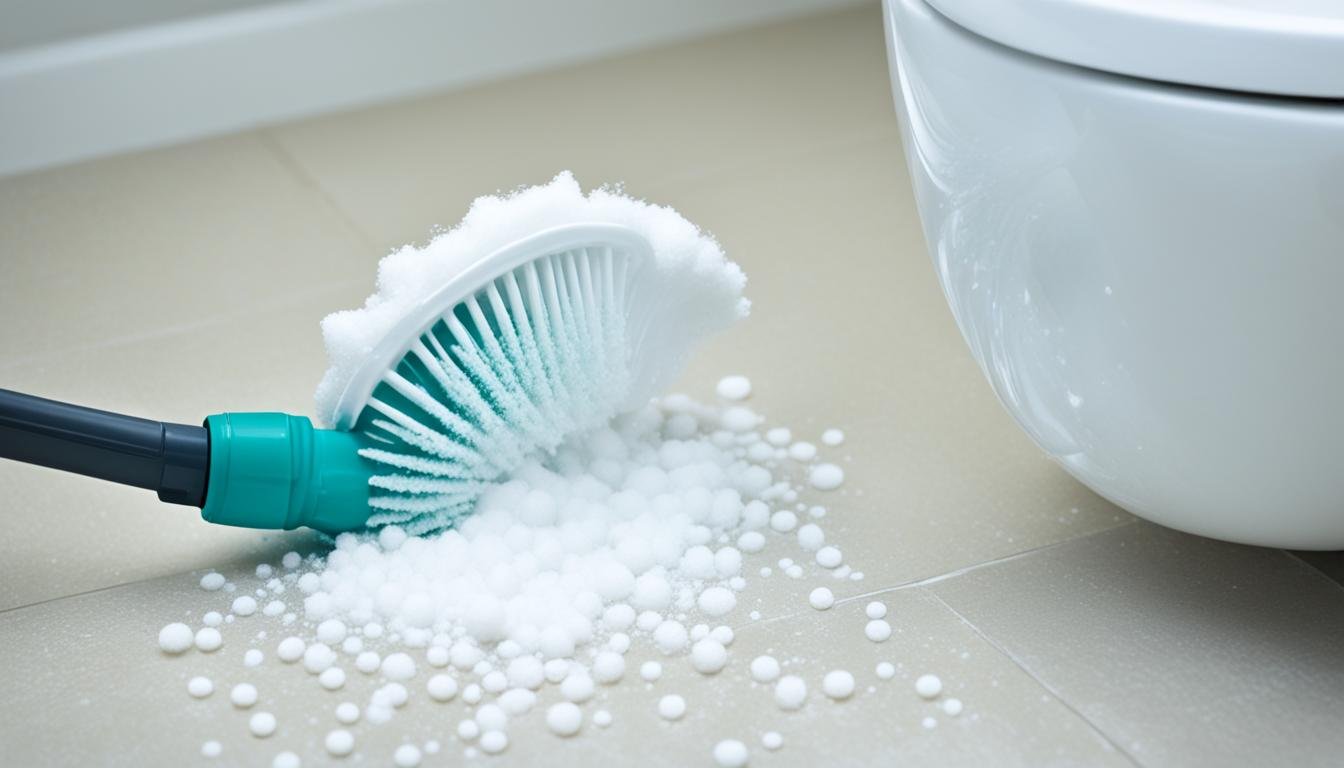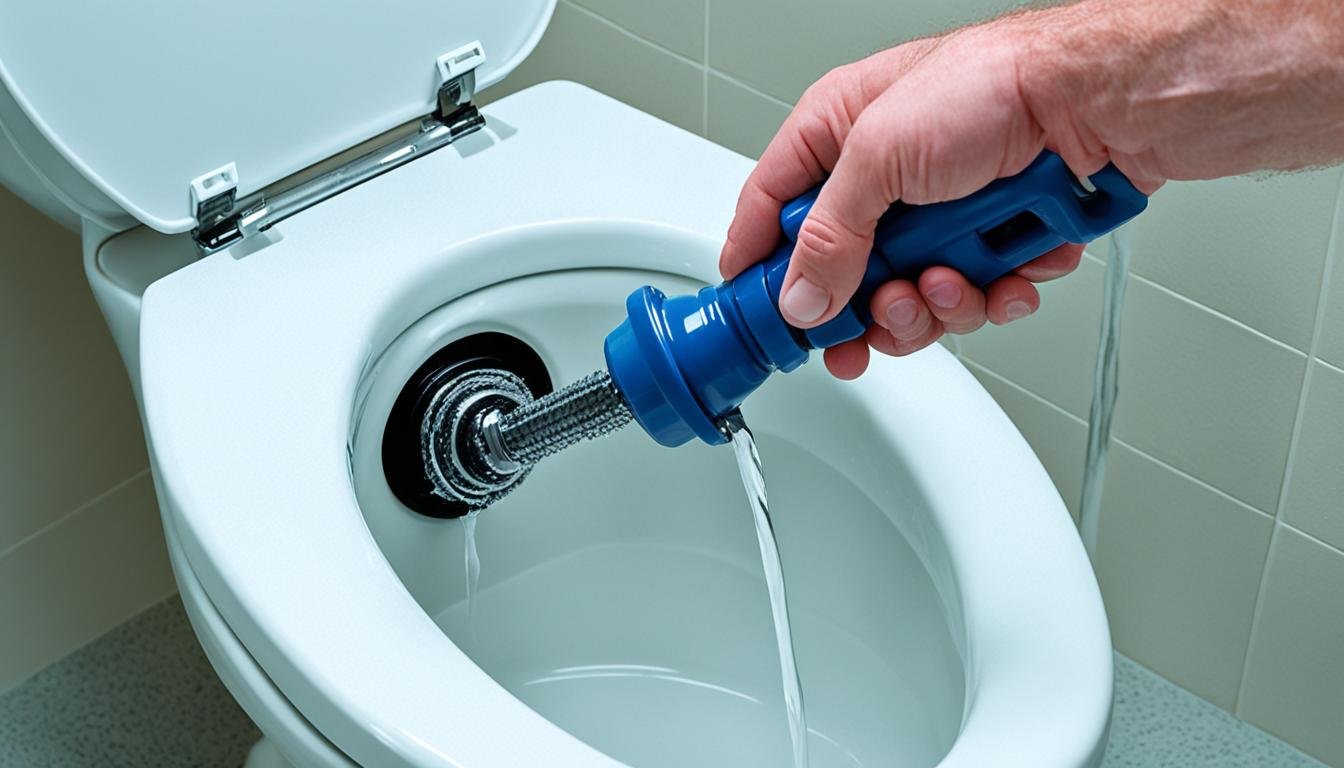Ever faced a clogged toilet and wondered how to fix it yourself? You’re not alone. Clogged toilets happen often, but you can fix them with the right tools.
We will show you how to clear a clog step by step. You’ll learn how a plunger, and sometimes a drain snake, can save the day. By the end, you’ll feel like a plumbing expert. Let’s start fixing your bathroom’s flow!
Key Takeaways
- Unclog your toilet quickly and efficiently using common household items like a plunger, baking soda, and vinegar.
- Understand the common causes of toilet clogs and the signs to look for to address the issue effectively.
- Learn how to properly use a drain snake or toilet auger to tackle stubborn blockages.
- Discover tips for preventing future toilet clogs through regular maintenance and avoiding clogging culprits.
- Know when it’s time to call in a professional plumber for a more complex clog.
So, how can you fix a clogged toilet without expert help? Let’s go step by step to make your bathroom work well again.
Understanding Clogged Toilets
Figuring out why your clogged toilet won’t flush is the first big task. Experts say the most usual causes of toilet clogs are flushing lots of toilet paper. Also, things such as feminine products and foreign objects can block the toilet. Finally, mineral buildup in the pipes over time can lead to a clogged toilet.
Common Causes of Toilet Clogs
Too much toilet paper is a big reason for causes of toilet clogs. While it’s made to dissolve in water, using too much can make it clump and block the pipes. Also, flushing things like baby wipes or foreign objects can cause a blockage.
Mineral deposits in the plumbing are another big cause of toilet clogs. Minerals from the water can slowly gather in the pipes. This makes the pipe’s width smaller over time and can cause a clogged toilet.
Signs of a Clogged Toilet
Knowing the signs of a clogged toilet is key to solving the problem quickly. The most common signs are a toilet that drains slowly, water that doesn’t go down, or water that rises instead of draining. These signs of a clogged toilet shouldn’t be ignored, as they can get worse with time.
Understanding the reasons behind causes of toilet clogs and knowing the signs of a clogged toilet helps homeowners. It lets them solve problems early and stop more blockages from happening.
Preparing the Tools
Before dealing with a clogged toilet, make sure you have the right essential tools for unclogging toilets. You’ll need a durable plunger, a drain snake or a toilet auger, and also some baking soda and vinegar. With these tools for unclogging toilets ready, you can fix the problem quickly and well.
Essential Tools for Unclogging Toilets
The essential tools for unclogging toilets are a plunger, a drain snake or a toilet auger, and some baking soda and vinegar. A plunger is good for small clogs since it creates suction to move the blockage. Need something stronger? A drain snake or toilet auger reaches further into pipes to tackle tougher clogs. Baking soda and vinegar are a natural, chemical-free way to dissolve the clog.
Safety Precautions
Dealing with a clogged toilet means taking safety precautions for unclogging toilets seriously. Wear rubber gloves to keep your hands safe, and use safety goggles to protect your eyes from splashing water. Also, make sure the area around the toilet is clear. Stand on solid ground to stay in control while fixing the clog.
Using a Plunger
Unclogging a toilet? A dependable plunger is your best friend. It’s the first tool to grab. With the right plunger and a good technique, you can clear a tough blockage. Soon, your toilet will work as good as new.
Selecting the Right Plunger
Choosing the right plunger matters a lot. You need one that can do the job well. Look for a plunger with a long, strong handle and a big, flexible rubber cup.
The cup should be bigger than the toilet’s drain. This way, it makes a tight seal. A strong seal means more powerful suction.
Proper Plunging Technique
Having the right plunger is just the start. The key is how you use it. Place the plunger right over the drain. Make sure it sticks well.
Now, push and pull the plunger hard, up and down. Do this in a steady rhythm. The suction it creates can clear the clog. Do this a few times, avoiding any splashes. Keep the seal tight the whole time.
Baking Soda and Vinegar Method
The baking soda and vinegar method is a natural way to unclog toilets. It’s easy and uses items from your kitchen. You start by adding baking soda, then vinegar. This causes a fizzy reaction that helps clear the blockage.
To use the baking soda and vinegar method, begin with a cup or two of baking soda in the bowl. Next, add the same amount of vinegar gently. The reaction will fizz and bubble, working to unclog the toilet.
Let the mix sit for about 30 minutes to an hour. You might hear the clog breaking up. Afterwards, flush to check if the toilet is clear.
If it’s not clear yet, try the steps again one or two times. This method is good for mild blockages. It’s a gentle way to clear the toilet before using stronger solutions.

Drain Snake or Toilet Auger
If a plunger or baking soda fix doesn’t work on a tough toilet clog, it’s time for a stronger tool. A drain snake or toilet auger can really help. They are made to break down and take out what’s blocking the toilet’s drain.
How to Use a Drain Snake
Using a drain snake to unclog toilet is quite simple. You start by putting the snake into the toilet’s drain hole. Then, turn the handle to send the snake down. The snake breaks through the clog, pulling it out as you turn the handle.
Keep turning the handle until the clog feels like it’s gone. That’s how you know the blockage is clear.
Precautions with Drain Snakes
Be very careful with a drain snake. Don’t push it too hard into the drain to prevent harm to the plumbing. Also, wearing gloves and eye protection is smart. This keeps you safe from gross water splashes. If you’re not sure about doing it or if there’s a lot of push back, get help from a pro to prevent more issues.
Preventing Future Clogs
Keeping your toilet in good shape is key to avoid the stress of clogs. By doing some simple toilet maintenance tips, you can cut down on future blockages. This will ensure your plumbing stays workable.
Toilet Maintenance Tips
It’s vital to do toilet maintenance often to stop clogs. Check for mineral buildup and debris in the tank and bowl regularly. Also, watch what you flush because items that are non-flushable often cause clogged toilets.
Avoiding Common Clogging Culprits
Flushing too much toilet paper is a big reason for toilet clogs. Use just enough and steer clear of large wads of paper or other blockage-causing items. By staying on top of toilet maintenance and being careful about what goes in, you’ll dodge many common clogging problems. This keeps your plumbing running well.
When to Call a Plumber
Many times, you can fix a toilet clog by yourself. Yet, if the problem is big or keeps happening, calling a plumber is smart. A qualified plumber can solve hard problems and prevent future issues.
Signs of a Serious Clog
If your toilet won’t drain despite your efforts, it’s a sign of a serious clog. Trying a plunger and home remedies with no luck means you need professional help. Also, if clogs happen often, it could show a larger plumbing problem. In this case, a skilled plumber is the best choice.
With a stubborn clogged toilet, don’t wait too long before calling a plumber. They’re equipped to tackle tough clogs without causing damage. Their help avoids more serious plumbing problems down the line.
how to fix a clogged toilet
Having a clogged toilet can be very frustrating. But, with the right steps, you can fix it. We will guide you through the process to fix a clogged toilet.
Step-by-Step Guide for Unclogging Toilets
The first thing to do is find out why your toilet is blocked. It could be too much toilet paper, an object, or build-up. Once you know the cause, you can choose the best way to fix the clogged toilet.
- Use a Plunger: A plunger is great for unclogging toilets. Make sure you have the right one. Place it over the drain and move it up and down to create suction. This helps clear the clog.
- Try Baking Soda and Vinegar: A natural method is to use baking soda and vinegar. Pour each into the toilet and let it sit. After 30 minutes, flush. The fizz can help dislodge the blockage.
- Use a Drain Snake or Toilet Auger: If a plunger doesn’t work, a drain snake or auger might. Insert it carefully into the toilet’s drain. Turn it to reach and clear the clog.
Always put safety first with a clogged toilet. Wear gloves and protect your eyes. Be careful with tools and chemicals. If the problem stays or you’re uncertain, get help from a pro. They can fix it safely and well.

Conclusion
This article gives a detailed guide on fixing a clogged toilet. It talks about what usually causes it, the tools needed, and step-by-step methods to fix it. We also discuss the importance of keeping it from clogging again. And when it’s time to call for expert help.
We cover everything from why toilets get clogged to how to use a plunger. We also touch on using baking soda and vinegar, even a drain snake. The guide helps readers learn how to manage issues with their plumbing. Key steps and cautions are given for ongoing toilet care and unclogging.
It’s always good to prevent clogs with regular checks and by not flushing the wrong things. This can lessen clogs and make your plumbing last longer. But, if a clog is too tough, it explains when to get a pro to handle it. They are trained to fix things right, ensuring your toilet stays clear.
FAQ
What are the common causes of toilet clogs?
“First source:” notes common causes like too much toilet paper, wrong items flushing, and mineral buildup.
What are the signs of a clogged toilet?
The “Second source:” shows signs like slow draining, water not moving, and rising water.
What are the essential tools for unclogging a toilet?
“First source:” names tools like a plunger, a drain snake, and baking soda plus vinegar.
How do you select the right plunger?
According to the “First source:”, pick a plunger with a strong seal and handle.
What is the proper plunging technique?
The “Second source:” describes effective plunging with steady up-and-down movement.
How do you use baking soda and vinegar to unclog a toilet?
The “First source:” tells how to use these. Start with soda, add vinegar, and let it react to loosen the clog.
How do you use a drain snake or toilet auger?
“First source:” explains for a drain snake or auger. Push into drain and crank to remove clog.
What are some tips for preventing future toilet clogs?
The “First source:” suggests regular checks to avoid buildup and not flushing objects that cause clogs.
When should you call a professional plumber for a clogged toilet?
The “First source:” advises when to seek professional help. If DIY doesn’t work, especially for severe or repeating clogs.
What is the step-by-step guide for unclogging a toilet?
This section gives a full guide, combining tips from before. It details how to use a plunger, baking soda and vinegar, and a drain snake or auger to clear a clog.